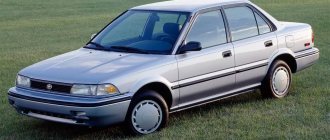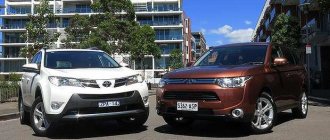During the recent restyling, the Toyota Corolla sedan was updated in accordance with customer wishes. To test how good he is, we pitted him against the Volkswagen Jetta, which many consider the standard in the class.
The list of changes in the exterior of the updated Corolla is, in general, standard - the changed “filling” of the headlights (which received LED high and low beams), a new bumper and rear lights, which also shone with diodes. But, if you put the pre-restyling version next to it, the latter will immediately seem outdated: the updated car looks clearly fresher and more dynamic than its predecessor.
In addition to changes in appearance, finishing materials in the cabin have been updated, sound insulation has been improved, the steering has been reconfigured (it has acquired a clearer zero position) and the suspension has been modified for better handling. The power units are the same - naturally aspirated petrol, but now they meet Euro 5 standards. These are a 1.3-liter engine with a capacity of 99 hp, a 1.6-liter 122-horsepower unit and, finally, a 1.8-liter engine , developing 140 hp.
The initial version is equipped exclusively with a 6-speed manual transmission, the most powerful - only with a continuously variable transmission. But the version with a medium engine (122 hp) can have both types of transmission. Prices for starting configurations start at 949,000 rubles and end at 1,277,000 rubles.
As for its rival, the Volkswagen Jetta, the model has been on the market for a long time; in a year or two we should wait for a new generation model. But the “old man” is still in service. His appearance is classic - Volkswagen, and therefore he looks prestigious and respectable, although a little boring.
The range of power units is a little more “refined” than that of its competitor. There are also three engines, but there are already four power options. Thus, the initial 1.6 liter naturally aspirated engine develops 90 hp. This is followed by a more modern unit of the same displacement with a capacity of 110 hp. And the third engine is turbocharged, with a volume of 1.4 liters, and it develops either 125 or 150 hp.
And for options with gearboxes, it’s even better to understand the configurator on the brand’s website. There are 5- and 6-speed manual transmissions, a 6-speed automatic transmission, and a 7-speed robotic DSG with two clutches. The price range for initial configurations is from 906,000 to 1,281,000 rubles.
We have tested configurations that are comparable in power. This is a 122-horsepower Toyota Corolla with a CVT, prices for which start at 1,096,000 rubles, and a 125-horsepower Jetta with DSG, asking for 1,192,000 rubles.
Engines
Toyota Corolla is equipped with three engines of 1.3, 1.6, 1.8 liters. All units have 4 cylinders.
The 1NR-FE is a 1329 cm³ engine. Maximum power - 99 hp, maximum torque - 128 Nm.
1ZR-FE - unit with a volume of 1598 cm³. The specific power of the engine in question is 122 hp, torque is 157 Nm.
The 2ZR-FE has a volume of 1797 cm³. The maximum power is 140 hp, torque is 173 Nm.
For the Volkswagen Jetta, the engine range includes 10 options.
1.2 TSI – unit with a volume of 1197 cm³. Maximum power - 105 hp, torque - 175 Nm.
The 1.4 TSI has a volume of 1390 cm³. Available in three versions. The maximum power can be 122 hp, 150 hp, 160 hp. torque - 200 Nm in the first case and 240 Nm - in the other two.
Volume 1.6 MPI – 1598 cm³. Maximum power - 105 hp, torque - 153 Nm.
2.0 MPI – unit with a volume of 1981 cm³. Maximum performance - 115 hp, 169 Nm.
The 2.0 TSI has a volume of 1984 cm³. Specific technical indicators - 200 hp. and 280 Nm.
2.5 MPI – 2474 cm³ engine. Maximum power - 170 hp, torque - 240 Nm.
1.6 TDI. Has a volume of 1598 cm³. Maximum power - 105 hp, torque - 250 Nm.
2.0 TDI – 1968 cm³ engine. Performance figures - 140 hp, 320 Nm.
Versions 1.6 MPI and 2.5 MPI are available for the US market.
Transmission
Both cars in question have front-wheel drive.
Toyota Corolla is equipped with two transmission options - a six-speed manual and a CVT.
A CVT called CVT Mulridrive S is available for the 1ZR-FE and 2ZR-FE engines.
A 6-speed manual transmission, which has a traditional design for such mechanisms, is available for the 1NR-FE and 1ZR-FE.
Manual, automatic and robotic gearboxes are available for the Volkswagen Jetta.
A 6-speed manual transmission is available for all engines except 1.6 TDI and 2.0 MPI, which are equipped with a 5-speed option.
Automatic 6-speed gearboxes are equipped with 1.6 MPI and 2.5 MPI.
The 1.4 TSI and 1.6 TDI engines are equipped with a robotic 7-range DSG gearbox. The 6-speed version comes with the 2.0 TSI and 2.0 TDI.
Appearance
The German Volkswagen Jetta sedan is built on the basis of the Golf, but it looks much larger and more solid - this is due to the increased wheelbase and the “appendage” in the form of a separate trunk. However, from the front, the car is more reminiscent of a Volkswagen Passat with its strict design and complex pattern of LED strips in the headlights. The wide opening in the front bumper of the Volkswagen Jetta and the radiator grille with powerful crossbars make the car look somewhat heavy, but this is exactly the impression that the manufacturing company’s specialists were trying to achieve. The only thing that confuses us is some angularity, which immediately catches the eye, but such is the new Volkswagen corporate style.
In profile, the Jetta looks very interesting, since some of the heaviness of the front end is offset by deep stampings, giving the car a dynamic appearance. Of course, they also do not go beyond the Volkswagen style, so the external solidity is not compromised at all. The picture is completed by the rear of the Volkswagen Jetta, which does without the massive bumper and flat trunk lid traditional for budget cars. The Jetta's taillights blend well with the elegant curve above the license plate and the reflectors in the rear bumper. The Volkswagen Jetta sedan leaves a pleasant impression, but it is impossible to say that it is completely original - rather, we see in front of us a kind of Passat in miniature.
A comparison of the two cars shows that they are both similar and radically different. The Toyota Corolla, created in Japan, is also somewhat angular, but it is complemented by smooth shapes and complex lines in the spirit of oriental architecture. The front of the Corolla looks unusual - wide headlights merge with the radiator grille and are emphasized by a wide rectangular slot in the bumper. The cutouts for the Toyota Corolla fog lights look not only original, but even aggressive. Toyota designers created a real miracle - they were able to give the car a bit of oriental luxury, but at the same time did not cross the border of bad taste, since they harmoniously merged it into modern fashionable style.
In profile, the Toyota Corolla looks even more angular than the Volkswagen Jetta, but this does not at all make the car ugly or archaic. At the rear there is also beautiful lighting technology and a bit of Asian luxury, but Corolla could not avoid the attributes of budget cars. The flat trunk lid and large convex bumper make the rear of the car too heavy and boring. Although in general the Toyota Corolla looks very harmonious and balanced, practically not inferior to its German competitor. Its main advantage is its unique design, which attracts attention, while the Volkswagen Jetta, similar to other models from the same manufacturer, does not arouse the same interest.
Suspension
At the front, the Toyota Corolla has an independent McPherson-type structure, and the rear suspension is a torsion beam. The track of both front and rear wheels is 1535 mm.
Ground clearance is 150 mm.
Controllability is provided by a rack-and-pinion steering mechanism equipped with electric power steering to facilitate control. Turning diameter - 5.4 m.
The Volkswagen Jetta is equipped with an independent McPherson front suspension. The rear suspension for low-power versions is represented by a beam, and for more advanced ones - a multi-link design.
The track is equal for both axles and is 1532 mm.
The car is equipped with a rack and pinion steering mechanism with electric power steering. The turning circle is 11.1 m.
Inner world
The difference in approaches is also visible in interior design. The Jetta's interior boasts comfortable seats with heating, adjustment and lateral support, a digital instrument panel visually combined with a multimedia screen, excellent sound insulation, dual-zone climate control and spaciousness on the back seat. Despite expensive materials and exemplary ergonomics, the interior looks discreet: the simpler the interior, the more attention is paid to the road.
The Corolla's interior is brighter and friendlier. The large, eye-catching multimedia screen above the climate control unit, color accents in the decoration, and the clear delineation of the central tunnel and the front panel with a digital instrument panel look unusual and the ergonomics do not suffer from this. But the seats in the back row are smaller: after all, the Japanese are a miniature nation.
But in terms of equipment and safety systems there is complete parity. Front and side airbags with curtains, disc brakes, cruise control, blind spot monitoring system, parking sensors, collision avoidance systems, braking assistants, hill start assist, ABS, EBD, VSC, HAC and many other devices form a single complex under control of on-board electronics. Hence the inevitability of touch screens: there is no longer room for analogue controls.
Body
Both cars are presented in a sedan body.
The length of the Corolla is 4620 mm, width - 1775 mm, height - 1465 mm. The wheelbase is 2700 mm.
The vehicle's curb weight is from 1270 to 1300 kg, depending on the configuration.
The car has a trunk volume of 450 liters.
The Volkswagen Jetta has a length of 4644 mm, a width of 1778 mm, and a height of 1453 mm. The wheelbase is 2651 mm.
The curb weight is 1272 to 1411 kg, depending on equipment.
The trunk capacity is 510 liters.
Dynamics
The least fast Toyota Corolla is available with a 1.33 engine and the only possible manual transmission with 6 speeds. Acceleration to 100 km/h takes her 12.6 seconds. the maximum speed is 180 km/h. The fastest Toyota Corolla is equipped with a 1.8 engine, for which one gearbox is also offered, represented by a CVT. Such a car accelerates to 100 km/h in 10.2 seconds and accelerates to 195 km/h. Although, the version with a 1.6 liter engine in combination with a manual transmission is close to it in terms of dynamics (10.5 s to 100 km/h) and equal in maximum speed.
The slowest Volkswagen Jetta is represented by a version with a 1.6 TDI engine. It accelerates to 100 km/h, both with automatic and manual transmission, in 11.7 seconds, and the top speed is 190 km/h. The version with a gasoline engine of the same volume is faster in acceleration to 100 km/h by 0.2 s, but has a lower speed of 10 km/h. The fastest in terms of dynamics is the Volkswagen Jetta with a 2.0 TDI engine. It takes her 6.6 seconds to accelerate. However, it is far from the first in terms of speed. Significantly ahead of it, namely by 28 km/h, is a car with a gasoline engine of the same displacement, capable of reaching 238 km/h, despite the fact that in acceleration it lags behind its diesel counterpart by 0.9 s.
Car price comparison
Volkswagen Jettas can please us with their pricing. For the basic configuration they ask, on average, about 1.049 million rubles, while for the base Toyota Corolla they will ask for at least 1.173 million rubles.
The TOP configuration of the Jetta will cost approximately 1.3 million rubles, but for the Corolla you will have to pay 1.7 million rubles, and this is without all sorts of extras.
However, if you are thinking about selling your car soon (planning to drive it for no more than 2-4 years), then the best choice is the Toyota Corolla. These cars have lost only 4.11% of their original value over the past 4 years, while the Volkswagen Jetta has lost almost 30% in price over the past 3 years (which, in principle, is the average figure for the entire market).
Change in the cost of Toyota Corolla over 4 years (2015-2019)
Change in the price of Volkswagen Jetta over 3 years (2016-2019)
Fuel consumption
The most economical, from this point of view, Toyota Corolla spends 4.7 liters, 7.2 liters and 5.6 liters per 100 km in suburban, urban and mixed modes. It is presented in a version with a 1.33 engine and manual transmission. The 1.6 engine coupled with a manual transmission consumes the most fuel, namely 5.4 l, 8.7 l, 6.6 l under the same conditions.
The tank volume is 55 l. The manufacturer recommends using AI-95 fuel for the car.
The 1.6 TDI version with manual transmission has the lowest consumption among Volkswagen Jetta modifications. It is 3.9 l, 5.7 l, 4.5 l per 100 km in the suburban, urban and combined cycles, respectively. The least economical car is equipped with a 2.5 liter engine and automatic transmission. It consumes 10 liters in suburban mode and 14.8 liters of fuel in urban conditions.
The fuel tank volume is 54 - 55 liters, depending on the modification. For versions equipped with gasoline engines, the manufacturer recommends refueling with AI-95.
Other options
Of course, car enthusiasts should also not forget that the cars mentioned here are not the only bright representatives in their class, and if desired, you can always choose another alternative option. In particular, in this class, the Czech new product that recently entered the Russian car market - Skoda Octavia - deserves attention. You can also think about buying a very beautiful Japanese model Mazda 3. And of course, you can’t discount the more affordable South Korean cars Hyundai Elantra and Kia Cerato.










